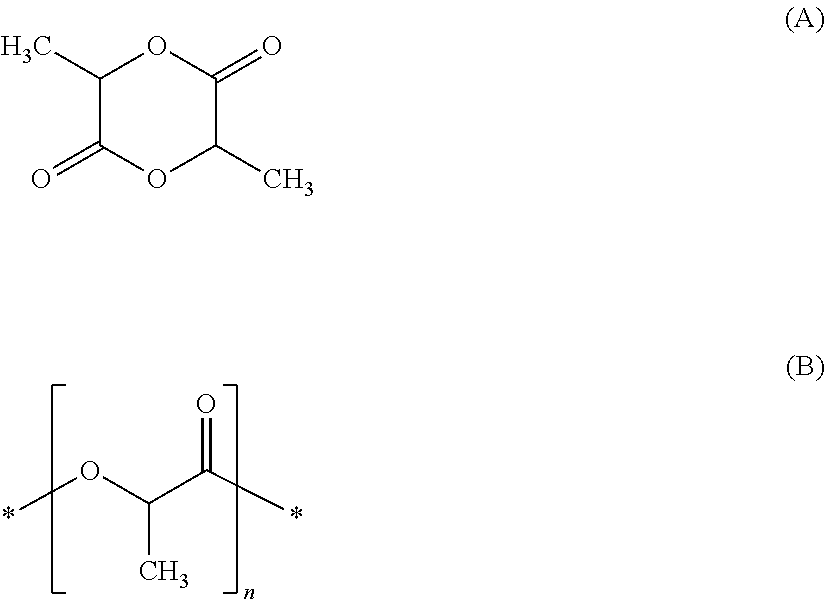Process for producing aqueous dispersions of thermoplastic polyesters
a technology of thermoplastic polyester and aqueous dispersions, which is applied in the direction of dissolving, chemical/physical processes, polyester coatings, etc., can solve the problems of affecting the performance of polyesters of that type, and being difficult to achieve complete removal of organic solvents without accepting some loss of dispersion quality
- Summary
- Abstract
- Description
- Claims
- Application Information
AI Technical Summary
Benefits of technology
Problems solved by technology
Method used
Image
Examples
production example 1
Polyester A1
[0216]Polybutylene terephthalate adipate, produced as follows: 583.3 g of terephthalic acid (27 mol %), 1280.2 g of adipic acid (73 mol %), 1405.9 g of 1,4-butanediol (130 mol %), and 37 g of glycerol (1.5% by weight, based on the polymer) were mixed together with 1 g of tetrabutyl orthotitanate (TBOT), where the molar ratio of alcohol component to acid component was 1.30. The reaction mixture was heated to a temperature of 210° C. and the water produced was removed by distillation at said temperature over a period of 2 h. The temperature was then increased to 240° C. and the system was evacuated in stages. Excess 1,4-butanediol was removed by distillation in vacuo (<1 mbar) over a period of 2 h.
[0217]The number-average molar mass of the resultant polyester A1 was 20,400 g / mol, and the weight-average molar mass was 140,000 g / mol. Intrinsic viscosity IV was 147. Melting point was 60° C. Zero-shear viscosity 110 at 180° C. was 630 Pa·s. The acid number was 0.6 mg KOH / g.
production example 2
Polyester A2
[0218]Polybutylene terephthalate adipate, produced as follows: 697.7 g of terephthalic acid (35 mol %), 1139.9 g of adipic acid (65 mol %), 1405.9 g of 1,4-butanediol (130 mol %), and 37.3 ml of glycerol (1.5% by weight, based on the polymer) were mixed together with 2.12 ml of tetrabutyl orthotitanate (TBOT), where the molar ratio of alcohol component to acid component was 1.30. The reaction mixture was heated to a temperature of 210° C. and the water produced was removed by distillation at said temperature over a period of 2 h. The temperature was then increased to 240° C. and the system was evacuated in stages. Excess 1,4-butanediol was removed by distillation in vacuo (<1 mbar) over a period of 1.5 h.
[0219]The number-average molar mass of the resultant copolyester was 16,300 g / mol, and the weight-average molar mass was 126,000 g / mol. Intrinsic viscosity IV was 131. Melting point was 80° C. Zero-shear viscosity η0 at 180° C. was 370 Pa·s. The acid number was less than...
production example 3
Polyester A3
[0220]Polybutylene terephthalate adipate, produced as follows: 697.7 g of terephthalic acid (35 mol %), 1139.9 g of adipic acid (65 mol %), 1405.9 g of 1,4-butanediol (130 mol %), and 37.3 ml of glycerol (1.5% by weight, based on the polymer) were mixed together with 2.12 ml of tetrabutyl orthotitanate (TBOT), where the molar ratio of alcohol component to acid component was 1.30. The reaction mixture was heated to a temperature of 210° C. and the water produced was removed by distillation at said temperature over a period of 2 h. The temperature was then increased to 240° C. and the system was evacuated in stages. Excess 1,4-butanediol was removed by distillation in vacuo (<1 mbar) over a period of 2 h.
[0221]The number-average molar mass of the resultant copolyester was 19,500 g / mol, and the weight-average molar mass was 178,000 g / mol. Intrinsic viscosity IV was 161.
[0222]Melting point was 80° C. Zero-shear viscosity no at 180° C. was 1,300 Pa·s. The acid number was less...
PUM
| Property | Measurement | Unit |
|---|---|---|
| zero-shear viscosity η0 | aaaaa | aaaaa |
| temperature | aaaaa | aaaaa |
| mol % | aaaaa | aaaaa |
Abstract
Description
Claims
Application Information
 Login to View More
Login to View More - R&D
- Intellectual Property
- Life Sciences
- Materials
- Tech Scout
- Unparalleled Data Quality
- Higher Quality Content
- 60% Fewer Hallucinations
Browse by: Latest US Patents, China's latest patents, Technical Efficacy Thesaurus, Application Domain, Technology Topic, Popular Technical Reports.
© 2025 PatSnap. All rights reserved.Legal|Privacy policy|Modern Slavery Act Transparency Statement|Sitemap|About US| Contact US: help@patsnap.com



